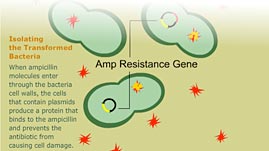Teachers' Domain - Digital Media for the Classroom and Professional Development
User: Preview

Source: University of Nebraska, Institute of Agriculture and Natural Resources
In this interactive activity adapted from the University of Nebraska's Library of Crop Technologies, learn how genes are cloned, or copied from one organism to another, using a multistep process that involves restriction enzymes and plasmids. The activity shows one bacterial cell "transforming" others with the addition of its DNA. The process naturally confers antibiotic resistance to the transformed bacteria, which in turn helps scientists isolate transformed bacteria from those that have not been transformed.
When most people hear the word "cloning," they probably think of reproductive cloning, the technology that gave us Dolly the sheep. Yet cloning can refer to something other than producing a genetic twin of another living thing. In therapeutic cloning, scientists harvest stem cells that can be used to study human development and to treat disease. This interactive activity features a third type of cloning: gene cloning.
Gene cloning refers to the technique of copying a specific DNA sequence. It can be useful in many areas of research and for biomedical applications, including the prenatal diagnosis of inherited diseases, large-scale production of hormones and other substances normally produced by the body, and the development of vaccines to prevent infection. Another such application, gene therapy, seeks to correct defective genes responsible for disease development in humans.
Gene therapy involves inserting normal copies of a gene into a diseased human's cells so that these cells can produce normal proteins. Delivering a cloned gene to a patient's cells can be done in a number of ways using one of several different types of vectors. Many applications of gene cloning use bacterial plasmids, as shown in the interactive activity, to carry genes into the target cells. However, when treating human patients with gene therapy, doctors use viruses to carry genes into cells.
It turns out that viruses—in particular, those which have been genetically modified to be harmless—are the ideal vectors because they have evolved many effective mechanisms by which they enter specific tissue cells. For example, gene therapy for cystic fibrosis, a genetic disease affecting respiratory cells, uses the common cold virus to deliver copies of the normal gene into these cells. This approach has yielded only limited results, largely because the body's immune system is designed to attack foreign invaders. Also, scientists cannot control precisely where the gene will be inserted in a patient's genome. If DNA is delivered to the wrong place, it could disrupt normal cellular function and cause more harm than good. If the DNA is not inserted into the patient's genome, it will not be copied or expressed, and will therefore be "lost."
Gene therapy is currently being used in clinical trials to treat some of the 2,800 known diseases caused by a single defective gene, most related to cancer and disorders of the blood, liver, and lungs. In time, it could potentially rid us of diseases that involve multiple genes, such as diabetes or heart disease. Unfortunately, in practice there have been many highly publicized setbacks to date. One of the main problems has been the inability to successfully deliver a cloned gene into the target cells.
 Loading Standards
Loading Standards Teachers' Domain is proud to be a Pathways portal to the National Science Digital Library.
Teachers' Domain is proud to be a Pathways portal to the National Science Digital Library.
